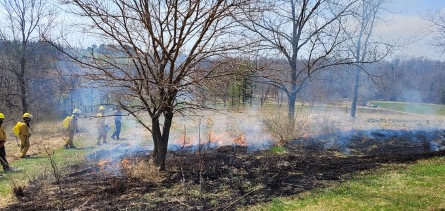Prescribed Burns: UW-Platteville History
Beginning fire-based land stewardship journey on campus
On April 1 and 6, a coalition of students and faculty from Facilities Management, the Reclamation, Environment and Conservation (REC) Program and the Department of Environmental Sciences and Society (formerly Department of Geography) conducted a pair of historic prairie burns. Fire plays a predominant role in land management and stewardship in prairie and grassland ecosystems. When invasive species of plants enter a prairie ecosystem, they pull resources away from species that grew there naturally. Over time, when left unaddressed, this can devastate local plants and wildlife.
“A really important system within the driftless area is prairies, and prairies are a fire-dependent ecosystem,” explained Dr. Evan Larson, professor in the Department of Environmental Sciences and Society. “If there is no fire, the trees start moving in, and once the trees start moving in, they shade out the grasses. Once the grasses are shaded, it’s less likely you’re going to get a fire, which means that there’s more trees.”
Dr. Larson and Dr. Christopher Baxter, the Program Coordinator for Reclamation, Environment and Conservation Department, guided the group of students as they learned to conduct prescribed burns. The group first burned the Greenhouse Savannah on April 1. This burn had originally been planned for last spring but was postponed after the university closed campus in the wake of the COVID-19 pandemic.
Diverging from the university’s approach in previous years, the Platteville Fire Department had attended the prairie burn to provide support rather than lead. This work was instead taken on by the group of students, under supervision by the PFD.
“If, for some unforeseen reason, something got out of control, we’d come and assist,” commented Fire Chief Ryan Simmons. “In the past, we did it jointly … we’ve now stepped aside and do more approval now.”
Leading and coordinating both prairie burns was Cory Ritterbusch, Burn Boss at Prairieworks, a local ecological restoration firm. Ritterbusch helped the students as they created water perimeters, ignition sites and safety zones.
“For over 20 years, I burned lands, private and for municipalities, prairies and savannahs and woodlands … (UW-Platteville) wanted a little assistance from somebody with a little more technical expertise and experience, so they hired me to be involved with the process.”
On April 6, the group continued their burn campaign by focusing on the solar panel array site in Memorial Park.This burn is unprecedented – in the 60 years that the park has been under the ownership of the university, this particular site been left unmanaged, and it shows with how poorly the landscape has developed, in comparison to other areas of the park that have received burns in the past. In effect, the land is set to go through a period of ecological restoration that will return it to its natural state.
As Dr. Larson described the park’s prescribed burn, “The intent is to establish a clear area for the array and to establish native vegetation beneath, because this is European vegetation not well suited to prairies or anything like that”.
Unfortunately, just as the group began to make some headway, the burn on the solar panel array site had to be postponed.
“We had to shut down the burn at the solar array site before it was 100% complete due to a shift in wind and smoke carrying onto the baseball and softball fields,” remarked Dr. Baxter, “but it was a great learning experience for our students and they responded very well when asked to put out the fire.”
Though the burn on April 6 had to be delayed and the site doesn’t yet reflect the development of a local prairie ecosystem, these volunteers are hopeful their efforts will pay off eventually. Traditionally, only students involved with the REC club could participate in and conduct prescribed burns. This semester, however, students enrolled in Baxter’s Reclamation Revegetation course, Larson’s Fire History and Ecology course and the REC Club combined forces to form a coalition of more than 20 students.
Considering prairie burns nearly disappeared from the United States for a time, a problem rooted in westward expansion by European settlers, some of the volunteers were ecstatic to share their passion for nurturing the environment and returning it to its natural state wherever they can.
“In the grand scheme of things, its righting what we’ve done. Maybe not me, not you, but humanity as a whole has damaged nature,” commented Rowan Wirth, a Senior Geography Major. “The personal reason for me is just because the world has done so much for me. So, this is my way of doing what I can. I want to make sure the earth that has cared for me is also cared for.”
Blossom Ramos, REC Club secretary and first-time burner, elaborated on her interests in conservation. “Coming to UW-Platteville got me really excited and I’ve had great professors that continue to inspire me, and opportunities presented through REC Club give me a chance to try field work.”
Dan Fisher, president of REC Club, noted that the hardest obstacle to allowing these burns was gaining permission for controlled burns within city limits, alongside liability coverage.“The goal is to make campus a more sustainable place,” continued Fisher, “to not only establish a burn management plan but change the fundamental thinking that ‘burning lands are bad’ … we will be a pioneer in making this happen.”




